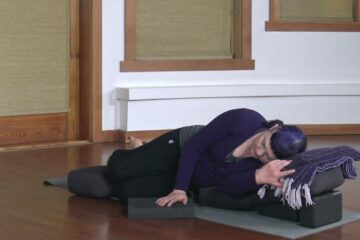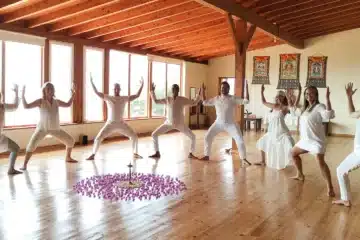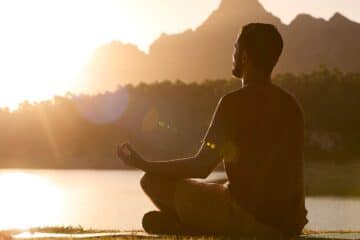For a restorative yoga sequence that promotes deep relaxation, start with gentle movements to release tension, followed by supported poses to calm the mind and relax the body. This sequence can help reduce stress and promote overall well-being.
Restorative yoga is beneficial for those seeking deep relaxation and stress relief. Incorporating restorative poses into your practice can enhance relaxation and rejuvenation, promoting a sense of calm and balance.
When done mindfully, this sequence can also help alleviate physical tension, reduce anxiety, and promote better sleep.
Whether you’re new to yoga or a seasoned practitioner, incorporating restorative yoga into your routine can offer a serene and restful experience. By focusing on deep relaxation, this sequence is a valuable addition to self-care practices.

Credit: www.amazon.com
Benefits Of Restorative Yoga
Restorative yoga sequence provides deep relaxation and numerous benefits, including stress reduction, improved sleep quality, enhanced flexibility, and increased mindfulness. This gentle practice promotes healing and rejuvenation by using supported poses and mindful breathing techniques.
Physical Benefits
Restorative yoga offers various physical benefits that contribute to overall well-being. Its gentle postures aid in relaxing the muscles, improving flexibility, and enhancing circulation. Through the use of supportive props, it promotes proper body alignment, allowing for deep relaxation and tension release.
The use of props in restorative yoga postures helps to alleviate fatigue, ease chronic pain, and promote the body’s innate healing mechanisms. The practice also aids in boosting the immune system and improving digestion, ultimately contributing to improved physical health.
Mental And Emotional Benefits
Restorative yoga holds significant mental and emotional benefits, fostering a sense of calm and inner peace. By engaging in deep, intentional breathing and long-held postures, individuals can experience a reduction in stress and anxiety levels, resulting in a quieter mind and a deeper connection to the present moment.
Moreover, the practice of restorative yoga has been found to enhance mental clarity, cultivate mindfulness, and promote emotional balance. The quiet, introspective nature of restorative yoga offers practitioners the space to nurture self-compassion, leading to an overall greater sense of well-being and tranquility.

Credit: www.amazon.com
Restorative Yoga Sequence For Deep Relaxation
Discover a restorative yoga sequence designed to induce deep relaxation and promote a sense of calm. With gentle poses and supported props, this sequence aims to release tension and rejuvenate the mind and body. Perfect for those seeking ultimate relaxation and restoration.
Sure! Here is the engaging section of the blog post about the Restorative Yoga Sequence for Deep Relaxation, focusing on the subheading: Restorative Yoga Sequence for Deep Relaxation. Introduction: In today’s fast-paced world, finding moments of deep relaxation is essential for our overall well-being. Restorative yoga offers a peaceful and meditative practice that allows the body and mind to unwind, promoting a sense of calm and deep relaxation.
Supported Child’s Pose
During this restorative yoga sequence, the Supported Child’s Pose, or Balasana, gently stretches the hips, thighs, and ankles while calming the mind. Centered around a bolster or folded blankets, the body can release deeply into a state of relaxation.
Reclining Bound Angle Pose
The Reclining Bound Angle Pose, or Supta Baddha Konasana, encourages a deep opening of the hips and chest, providing a sense of release and ease. Support yourself with pillows and blankets to fully surrender into this meditative posture.
Legs-up-the-wall Pose
During the Legs-up-the-Wall Pose, or Viparita Karani, the legs are elevated to reduce tension and promote circulation. Supported by props, this gentle inversion encourages relaxation while relieving fatigue and stress.
Supported Corpse Pose
The Supported Corpse Pose, or Savasana, invites a profound sense of relaxation and surrender. With the body fully supported by props, this posture allows for complete rest and rejuvenation of the mind and body.
Supported Bridge Pose
Supported Bridge Pose provides a gentle backbend that releases tension in the spine and chest while calming the nervous system. With the support of props, this restorative posture fosters deep relaxation and renewal. Incorporating these restorative yoga postures into your practice can help facilitate deep relaxation, ease stress, and promote overall well-being. Allow the soothing support of props and the gentle movements of the body to guide you towards a state of profound relaxation and tranquility.
Frequently Asked Questions For Restorative Yoga Sequence For Deep Relaxation
What Is Deep Relaxation Yoga?
Deep relaxation yoga is a practice that helps release tension and promotes overall relaxation. It involves gentle poses, deep breathing, and meditation to calm the mind and relax the body. This form of yoga helps reduce stress, increase mindfulness, and improve overall well-being.
What Is Restorative Relaxation?
Restorative relaxation is a method that helps recharge the body and mind, promoting deep rest and rejuvenation. It involves techniques such as meditation, deep breathing, and guided imagery to reduce stress and enhance overall well-being.
How Do You Structure A Restorative Yoga Class?
Structure a restorative yoga class with gentle warm-up, followed by relaxing poses using props. Incorporate deep breathing and mindfulness techniques. Focus on holding poses for extended periods, promoting deep relaxation. End the class with a calming savasana and meditation. Tailor the sequence to suit the students’ abilities and needs.
What Is Most Relaxing Practice Of Yoga Called?
The most relaxing practice of yoga is called “Restorative Yoga,” which focuses on deep relaxation and stress relief. It involves using props to support the body in comfortable, long-held poses, promoting a sense of calm and rejuvenation.
Conclusion
Restorative yoga offers a wonderful way to unwind and achieve deep relaxation. By incorporating gentle postures, breath work, and mindfulness, this sequence helps to release tension, reduce stress, and promote overall well-being. Regular practice of this restorative yoga sequence can enhance your physical and mental health, allowing you to find inner peace amidst the chaos of daily life.
So, set aside some time for yourself, roll out your yoga mat, and embark on a journey of tranquility and restoration. Namaste.



